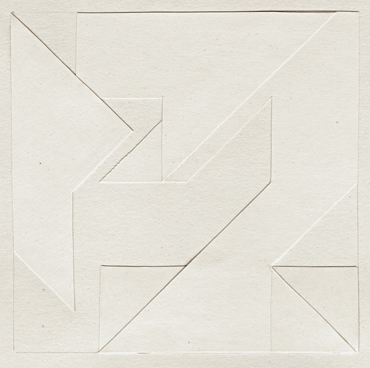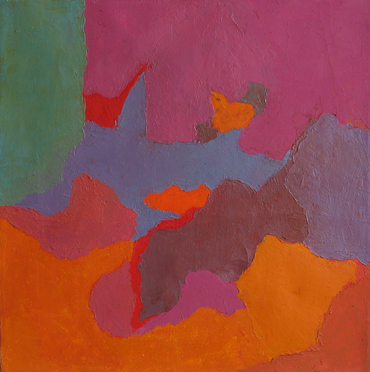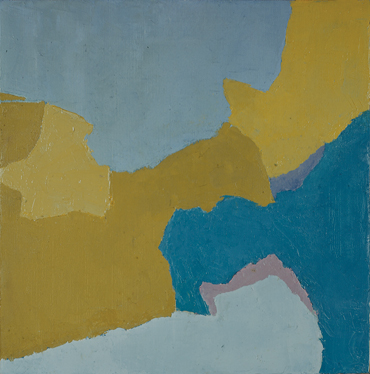However, it would contradict the Šejn consistency if he did not try to acquire the most classical art media, when he had the opportunity to do so, as he did at the Zdeněk Sýkora school. But while learning about the theoretical interpretations of Paul Klee and Josef Albers was almost immediately a stimulus for the whole cycle of geometric realizations, especially collages, then the study of painting was gradual – but we should not be surprised, because painting was not presented by a teacher as a sum of technological knowledge (although it is quite extensive and nobody can master it in life, even if it is used).
 Miloš Šejn: Morphological study, 1977
Miloš Šejn: Morphological study, 1977
Painting also means the entire history of the foundations and foundations of modern art… The painting has always been the only goal for Sýkora, he considers the painting to be the sovereign whole through which the painter enters the world around him, not only into the world of art (of course, also, but not only!). The seriousness he attributes to him is absolute, greater than most things in the other world around us, many of which are of little importance to him. There is already an understanding of the work, and for Sykora solely of the image as something capable of transcending the reality in which we find ourselves. That is a fundamental artwork as equivalent, be formed in any medium. Sýkoras passing of such experience means that through the medium of painting, a painting, we become both articles of a certain tradition, consisting of what our predecessors and possibly what we have already realized, but at the same time we transcend it not only with novelty, authenticity of our message, also by his ability to enter into the “world we live in” (I deliberately recalled the ancient programming words of Jindřich Chalupecký, which foreshadowed the current desire to break out of mere keeping in a modernist tradition and transcend it - perhaps even the most banal… Painting, derived from the practice of Sýkora pedagogy, is a limited chapter in Šejns endeavor, both in terms of time and significance, but it certainly belongs to this sum and cannot be ignored as if we should not neglect his purely geometric compositions. I would like to see both of these subchapters as his “journeying years” when he responded to what artists had done and thought about one or two generations older and created distinctive variations of what they and many others brought. We must not take into account the chronological sequence; Šejn has already had the whole experience of his own conceptual thinking, reflected in photographs, texts and collections. But at the same time, he was tempted - and his age practically allowed - to become acquainted with the secrets of other media, for art XX. It was also possible to identify the conceptual line, beginning with the prophetic gestures of Marcel Duchamp. But Šejn also wanted to learn the secrets of painting, both as compositions and paintings. Therefore, he invented in our environment so little studied teachers in the form of great world personalities Paul Klee and Josef Albers, therefore he also decided for a painting "dressage" (which, however, lacked much humor) Zdeněk Sýkora. He enriched his experience and variety of his own work and also brought something special to the category of painting thanks to his experience from working in nature. However, this had to be preceded by Sýkoras training - in order to transform it into something distinctive, which in turn enriches the category of Czech abstraction of the 1970s and 1980s. This was no pure radical geometry, and we can see that this was a new experience in a certain aspect of a mature, clear-cut artist - but after all Sýkora himself had once followed a similar path when he first enthusiastically coped with surrealism, then with the strictness of cubism, all in the first half of the 1940s, to take a gradual journey from Impressionism to Matissian fauvism for a few years.
 Miloš Šejn: Zebín Hill, 1980
Miloš Šejn: Zebín Hill, 1980
In another context of the time, with different dispositions and backgrounds, Šejn responded to actually similar phenomena in the field of modern painting. As if he wanted to leave out no way to prove to himself and others that his art had the most classical foundation. I do not consider it necessary, I believe that some filmmakers can enter directly in medias res and start to deal with a very responsible issue, so to speak "in the air”. Šejn thus entered the path of autonomous creation, but took advantage of the fact that his professional background could be enriched and at the same time provide him with other experiences of discovering something unknown... for Šejn, though a few years later he found out that for him himself the paintings made are quite different from the traditional painting - direct work with natural pigments in situ.
Part of the text - Jiří Valoch: Portrait of an Artist in a Young Age /
ŠEIN, 2003
 Miloš Šejn: Zebín Hill, 1980
Miloš Šejn: Zebín Hill, 1980
 Academy Archives
Academy Archives 